Best AI Nvidia GPUs for deep learning 2025
Choosing the right GPU for AI and deep learning is a crucial decision, as it can significantly impact the performance and efficiency of your machine learning projects. In this comprehensive guide, we will explore the key factors and considerations you should keep in mind when selecting a GPU for AI and deep learning applications.
What is important when choosing a GPU for AI?
The first step in choosing a GPU is to understand the specific requirements of your AI and deep learning workloads. Different tasks, such as image recognition, natural language processing, or reinforcement learning, may have varying demands on GPU capabilities. Make sure to assess the complexity and scale of your projects to determine the computational power you need.
The GPU's memory, or VRAM (Video Random Access Memory), is crucial for handling large datasets. Deep learning models, especially in tasks like computer vision, may require substantial VRAM. Ensure that your GPU has enough memory to accommodate your dataset, or you may face performance bottlenecks because deep learning models can be very large. In terms of memory itt is very important to choose a graphics card with enough memory to store the model and the training data. A good rule of thumb is to choose a graphics card with at least 40GB of memory.
Deep learning models often require a lot of data to be transferred between the GPU and the Memory. A higher bandwidth graphics card will be able to perform deep learning workloads faster. High memory bandwidth is essential for quick model training and inference. Check the memory bandwidth specifications of the GPU models you are considering. The higher this number, the better.
Deep learning models can be trained using either half-precision (FP16) or single-precision (FP32) arithmetic. FP16 arithmetic is faster, but it can lead to less accurate results. FP32 arithmetic is slower, but it is more accurate. For most deep learning workloads, it is recommended to use FP32 arithmetic. The precision and compute capability of a graphics card determines how well it is suited for deep learning workloads. Higher precision and higher compute capability graphics cards will be able to perform deep learning workloads faster.
In addition to these factors, you may also want to consider the following when choosing an AI graphics card for deep learning, some other factors, such as cooling, power consumption and software support must be taken into consideration. Deep learning workloads can generate a lot of heat, so it is important to choose a graphics card with good cooling. Deep learning workloads can consume a lot of power, so it is important to choose a graphics card that is efficient in terms of power consumption. But perheaps the most important is to choose a graphics card that is supported by the deep learning software that you plan to use.
Why Nvidia?
In short: they have the best softwar support
NVIDIA GPUs have been the most popular choice for AI and deep learning due to their CUDA support and dedicated deep learning libraries like cuDNN. NVIDIA GPUs have the best support in terms of machine learning libraries and integration with popular frameworks, such as PyTorch or TensorFlow2. NVIDIA also provides a software development kit (SDK) called NVIDIA CUDA-X AI, designed for developers and researchers building deep learning models3. This libraries work with the dedicated video RAM (VRAM) on the graphics card, enabling you to accommodate large datasets4. Many operations in deep learning can be run in parallel, meaning they can be calculated independently then aggregated later. NVIDIA GPUs are designed to perform multiple, simultaneous computations, which enables the distribution of training processes and can significantly speed up machine learning operations4.
Which Nvidia GPUs are best for AI and why?
- NVIDIA Tesla A100
- NVIDIA Quadro RTX 8000
- NVIDIA Quadro RTX 6000
- NVIDIA Titan RTX
- NVIDIA Geforce RTX 3090
NVIDIA Tesla A100
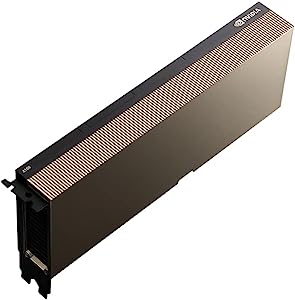
The A100 is one of the most powerful AI graphics card on the market, offering up to 312 teraFLOPS of deep learning performance. This means that it can train and deploy AI models much faster than other graphics cards. In terms of memory, the A100 has 40GB of GDDR6 memory, which is enough to store large AI models. This means that you can train and deploy large AI models without having to worry about running out of memory. The A100 has a bandwidth of 1.6 TB/s, which means that it can transfer data to the GPU very quickly. This is important for AI workloads, which often require a lot of data to be transferred.
The A100 has a number of features that make it ideal for AI workloads, such as Tensor Cores, Multi-Instance GPU (MIG) technology, and support for NVIDIA's CUDA programming platform. Here are some specific examples of how the NVIDIA A100 is being used to accelerate AI workloads:
Google AI is using the A100 to train and deploy its latest AI models, such as LaMDA and Imagen. Microsoft Azure is using the A100 to power its AI services, such as Azure Machine Learning and Azure Cognitive Services. Amazon Web Services (AWS) is using the A100 to power its AI services, such as Amazon SageMaker and Amazon Rekognition.
The NVIDIA A100 is a powerful and versatile AI graphics card that is well-suited for a wide range of AI workloads. It is the ideal choice for organizations that need to train and deploy AI models quickly and efficiently.
NVIDIA Quadro RTX 8000
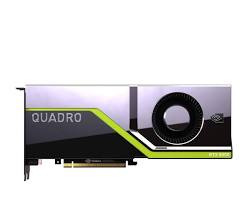
The Quadro RTX 8000 is a professional-grade graphics card that is designed for AI and other high-performance computing workloads. It features 4608 CUDA cores, 48GB of GDDR6 memory, and a bandwidth of 768 GB/s.
The Quadro RTX 8000 is one of the most powerful graphics cards on the market, offering up to 130 TFLOPS of deep learning performance. This makes it ideal for demanding professional workflows, such as 3D rendering, video editing, and artificial intelligence. It has a decent amount of memory, which is enough to handle even the most complex datasets and models. This means that you can work with large and complex projects without having to worry about running out of memory. It has a number of features that make it ideal for professional workflows, such as hardware-accelerated ray tracing, support for NVIDIA's CUDA programming platform, and certification with a broad range of professional applications.
NVIDIA Quadro RTX 6000
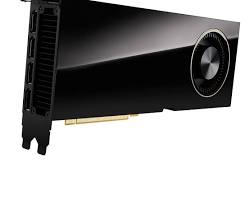
The RTX A6000 is another professional-grade graphics card that is designed for AI and other high-performance computing workloads. It features 8192 CUDA cores, 48GB of GDDR6 memory, and a bandwidth of 896 GB/s.
The RTX A6000 offers up to 40 TFLOPS of single-precision performance and 312 TFLOPS of deep learning performance. This makes it ideal for demanding professional workflows. The RTX A6000 also has 48GB of GDDR6 memory, which is enough to use it for AI applications. The RTX A6000 has a bandwidth of 896 GB/s, which means that it can transfer data between the GPU and the CPU very quickly.
3D artists are using the RTX A6000 to create realistic and detailed 3D models and scenes. Video editors are using the RTX A6000 to edit high-resolution video footage and create complex visual effects. AI researchers are using the RTX A6000 to train and deploy AI models for a variety of applications, such as image recognition, natural language processing, and machine learning. Scientists and engineers are using the RTX A6000 to perform complex simulations and data analysis. In addition to its performance, memory, bandwidth, and features, the NVIDIA RTX A6000 is also a very reliable and stable graphics card. It is designed for professional use, and it has been thoroughly tested and certified by NVIDIA. This makes it a great choice for professionals who need a graphics card that they can depend on.
Overall, the NVIDIA RTX A6000 is a great graphics card for a wide range of professional workflows. It is powerful, versatile, and reliable. It is the ideal choice for professionals who need a graphics card that can deliver high performance, large memory, powerful features, and reliability.
NVIDIA Titan RTX
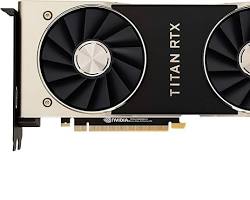
The Titan RTX is NVIDIA's most powerful consumer graphics card, and it is ideal for AI workloads. It features 5472 CUDA cores, 24GB of GDDR6 memory, and a bandwidth of 672 GB/s.
The NVIDIA Titan RTX is a powerful GPU designed for researchers, developers, and creators. It’s powered by Turing architecture, which brings 130 Tensor TFLOPs of performance to your PC. The Titan RTX is capable of transforming a PC into a supercomputer for AI researchers and developers. It provides multi-precision Turing Tensor Cores for breakthrough performance from FP32, FP16, INT8, and INT4, allowing faster training and inference of neural networks. Furthermore, it supports NVIDIA’s CUDA-X AI SDK, which includes cuDNN, TensorRT, and more than 15 other libraries3. This makes it compatible with all popular deep learning frameworks and NVIDIA GPU Cloud (NGC)3. The Titan RTX is also equipped with NVIDIA NVLink, which can effectively double the memory capacity to 48 GB, enabling researchers and data scientists to experiment with larger neural networks and datasets.
NVIDIA Geforce RTX 3090
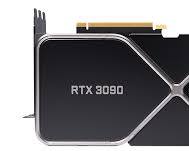
The RTX 3090 is another excellent choice for AI workloads. It features 10496 CUDA cores, 24GB of GDDR6X memory, and a bandwidth of 936 GB/s. It was released in September 2020. It is based on the NVIDIA Ampere architecture. It is capable of delivering up to 19.5 TFLOPs of single-precision performance and 312 TFLOPs of deep learning performance.
The RTX 3090 is ideal for demanding gaming and professional workloads. It can handle even the most demanding games at 4K resolution and high frame rates. It can also be used for professional workloads such as 3D rendering, video editing, and artificial intelligence.
How to choose the best AI GPUs
The choice of GPU can depend on various factors such as the scale of your project, budget, and specific requirements3. It’s also important to consider the supporting software, ability to interconnect multiple GPUs, data parallelism, GPU memory use, and performance
Which graphics card is best for you will depend on your specific needs and budget. If you are looking for the most powerful graphics card available, the Titan RTX is the best choice. If you are looking for a more affordable option, the RTX 3090 is a great alternative. If you need a professional-grade graphics card, the Quadro RTX 8000 or RTX A6000 are excellent options.
How to build a PC for deep learning
Building a PC for AI and deep learning operations is a meticulous endeavor, demanding a well-thought-out selection of hardware components. To unlock the potential of machine learning and neural networks, one must create a system that marries computational power with efficiency. This guide presents key considerations for assembling such a PC. From the choice of a high-performance CPU and potent GPUs to ample RAM, storage, and cooling solutions, each component plays a pivotal role in achieving optimal performance. With the right configuration, your AI workstation becomes a robust ally for tackling complex deep learning tasks with precision and swiftness. In the next table we list some of the components we recommend to use if you decide to take on this journey.
| Hardware components | Suggested paramters |
| CPU | Chooe an Intel CPU to avoid compatibility issues. The Intel Core i9-13900KS, running at 6 GHz is a good choice. This CPU uses LGA 1700 socket |
| RAM | 64 GB RAM is the minimum recommended, use DDR5 RAMs for best performance |
| GPU | Select one from the list above |
| Motherboard | Make sure the one you choose is compatible with your CPU and has PCIe slots for the GPUs. The Asus ROG Z790 motherboard can host the Intel Core i9-13900KS CPU thanks to it's LGA 1700 CPU socket. This motherboard has two PCIe 5.0 slots, so it can host 2 NVidia GPUs. |
| Power supply | Minimum 750W |
| Case | Large case with good cooling |
| Storage | Use an Gen4 NVMEe SSD. Make sure it is at least 2TB. A 4TB one is even better. Make sure the one you choose can handle 3GB/s read/write speeds |
For operating System, a linux distribution is needed. The best choice is Ubuntu. Ubuntu is the most widely used OS for deep learning due to their support for AI libraries and frameworks. On Ubuntu you can install the deep learning frameworks you plan to use, such as TensorFlow, PyTorch, or Keras. After setup ensure they are GPU-accelerated and configured properly.
After the PC is setup consider installing GPU monitoring tools to keep track of temperature and utilization during training.
Note that using a PC lacking sufficient hardware resources for AI deep learning poses several significant dangers. First and foremost, inadequate hardware can result in excruciatingly slow training times, hindering productivity and limiting the scale and complexity of models that can be tackled. Moreover, running resource-intensive AI workloads on underpowered systems may lead to system instability, overheating, and even hardware damage. It can also strain the PC's lifespan, causing premature wear and tear. Data loss and project setbacks are potential consequences when insufficient memory and storage are unable to accommodate the vast datasets required for AI tasks. Inaccurate and unreliable results may emerge due to hardware limitations, potentially leading to incorrect conclusions or flawed decision-making. In summary, the dangers of using an underpowered PC for AI deep learning encompass diminished efficiency, hardware risks, and compromised project integrity.
Nvidia AI GPU prices
In Oct. 2023 the prices for the above GPUs were around:
| NVIDIA Tesla A100 | $8000 |
| NVIDIA Quadro RTX 8000 | $5500 |
| NVIDIA Quadro RTX 6000 | $3800 |
| NVIDIA Titan RTX | $2000 |
| NVIDIA Geforce RTX 3090 | $1000 |
Conclusion
In conclusion, AI GPUs represent a pivotal cornerstone in the evolution of artificial intelligence and deep learning. These specialized hardware components have redefined the boundaries of computational power, enabling us to explore and unravel complex problems that were once deemed insurmountable. As we've journeyed through this article, we've witnessed the remarkable capabilities of AI GPUs, from their parallel processing prowess to their support for mixed-precision operations. They have transformed the way we approach data analysis, pattern recognition, and machine learning, accelerating the pace of innovation in countless fields.
However, as AI continues to advance at breakneck speed, the significance of selecting the right GPU cannot be overstated. It is vital to consider factors like architecture, memory capacity, and compatibility with deep learning frameworks when making a choice. Moreover, the optimization of AI software, drivers, and cooling solutions is equally crucial to harness the full potential of these GPUs.
In a world where the application of AI knows no bounds, the GPU remains a beacon of innovation, empowering us to reach new heights in AI research, and in the process, reshaping the way we live, work, and interact with technology. The journey of AI GPUs is far from over, and as they continue to evolve, the horizons of what we can achieve with artificial intelligence will only expand further.
